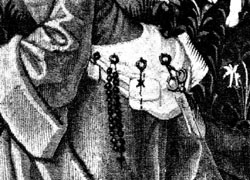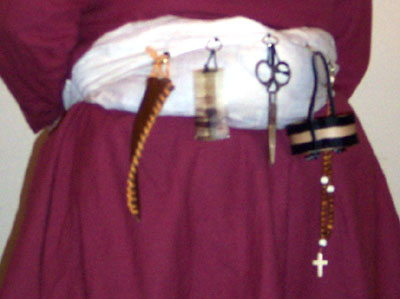

Main Menu - Misc. - Clothing/Textiles - Medieval Wales - Names - Other Medieval - Publications - Harpy Publications
Return to main page
I chose the experiment from the crescent-shaped style to try attaching rings and tools to, as it seems closest to the style seen in the early 16th century tapestries where this type of attachment is normally found.


(I intend to add close-ups of the various attached tools, but they are not yet available.)
I sewed five brass rings (ca. 3/4" diameter) at intervals of 2 1/2" centered on the outer edge of the pouch (i.e., the "flap"), and fastened to the folded hem for greater strength. When the objects are attached to these rings, they increase the stability of the pouch as a container and don't tend to pull it out of position. The weight of the objects I used is actually relatively slight in this context.

Unless there is some way to untie the scissors, or they are never removed from the ring, they end up hanging somewhat lower than the pictures tend to show. The attachment cord is shown going through the loops, so to be able to remove the scissors from the ring, the loop must be long enough to go through the ring and then over the tips of the scissors. A length sufficient to do that will not impede opening the scissors for use.
The comb, on the other hand, works with a fairly short cord. The loop only needs to be long enough to reach from one side of the central spine to the tip of the opposite tines. When the cord is in position around the spine (at one end), it does not tend to become loose, especially if the cord is large enough to fit snugly between the tines.
I haven't had time to experiment with oval boxes of the types that I believe to appear in the pictures, but I was able to use a small cardboard gift-box of the right shape and with a close-fitting lid for experiments. The cardboard, unfortunately, was too thick and stiff for slits for straps in the way the pictures appear to show, so I approximated them by gluing strips of braid around the edge of the lid and the bottom of the box, leaving a small unglued section at the middle of the long sides. Through these, I threaded a leather lace, going through the ring at the top, and then knotted the lace at both ends so that it wouldn't slip through the slots in the trim. This arrangement (which functions the same way slits in the box itself would) allows the lid to be removed for access without removing the box itself from its attachment. When hanging loose, gravity (and the tight fit of the lid) will keep the lid in place.
I haven't had a chance yet to experiment much with other types of attachments. I have one knife of approximately the right size that works fairly well. but no whistle of the right type. The knife attachment ise fairly straightforward, as it is the sheath that is tied to the pouch, with the knife able to come free. (At least one of the depictions has markings that may show the knife being tied into the sheath by a small cord.) The whistles are a harder case, as they clearly can't be played while attached to the pouch, and unless the cord has an easy-release knot (which is not depicted in the art) I don't see how it would be removed. I'm assuming through all this that the rings are functionally solid, as they appear to be in the pictures. If they are the equivalent of split-rings, then a great many different arrangements are possible. (I used split rings in my experiment only because they were the only ones I could find of the right size.)
Previous --------------------------------------------- Main --------------------------------------------- Next
This site belongs to Heather Rose Jones. Contact me regarding anything beyond personal, individual use of this material.
Unless otherwise noted, all contents are copyright by Heather Rose Jones, all rights reserved.